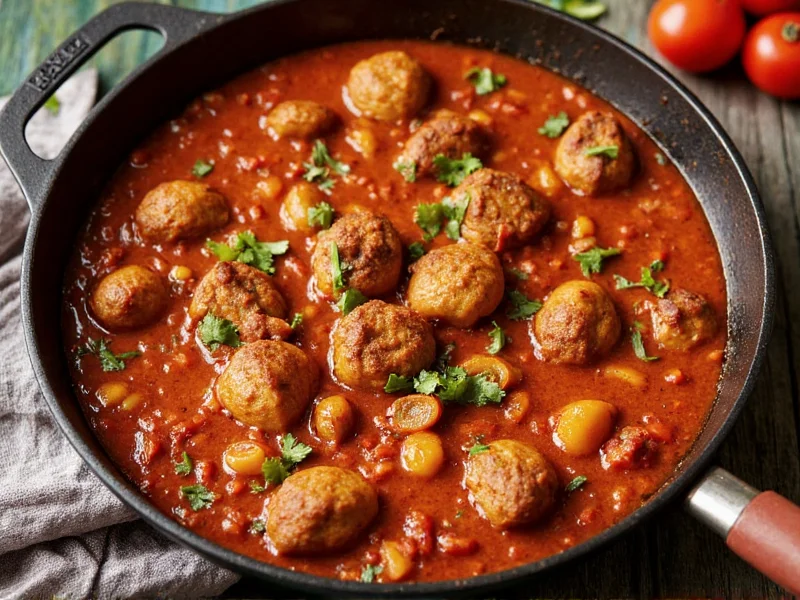Tikka Marsala is a popular Indian dish consisting of marinated, grilled meat pieces (tikka) served in a rich, creamy tomato-based sauce (marsala) flavored with aromatic spices like garam masala, ginger, garlic, and fenugreek. Despite the name, it contains no Marsala wine—the “marsala” refers to the spiced sauce preparation method.
When you ask what is tikka marsala, you're exploring one of the most beloved dishes in Indian cuisine that has gained international popularity. This flavorful creation combines tender pieces of protein with a complex, aromatic sauce that balances tangy tomatoes, creamy dairy, and warm spices.
Breaking Down the Name: Tikka vs. Marsala
The term “tikka” comes from the Punjabi language and refers to “small pieces” or “bites.” Traditionally, tikka describes meat (most commonly chicken) cut into chunks, marinated in yogurt and spices, then cooked in a tandoor (clay oven). The “marsala” component is often misunderstood—it doesn't contain the Italian Marsala wine. Instead, “marsala” in this context refers to a specific style of spiced tomato-based sauce preparation common in North Indian cooking.
Historical Origins and Cultural Context
Tikka Marsala originated in the Punjab region of India and Pakistan, where tandoor cooking has been practiced for centuries. The dish evolved as Indian chefs adapted traditional recipes for Western palates during the 20th century. Unlike many ancient Indian recipes, Tikka Marsala as we know it today is relatively modern, gaining widespread popularity through Indian restaurants worldwide.
It's important to distinguish authentic Tikka Marsala from its restaurant-variety counterparts. Traditional versions use fewer cream and more tomato base than Westernized versions, creating a more balanced flavor profile that showcases the complex spice blend rather than overwhelming richness.
Key Ingredients That Define Authentic Tikka Marsala
Understanding what tikka marsala ingredients include helps appreciate its distinctive flavor:
| Component | Essential Ingredients | Function |
|---|---|---|
| Tikka (Meat) | Chicken, paneer, or vegetables; yogurt; lemon juice; ginger-garlic paste; garam masala; turmeric; red chili powder | Provides tender, flavorful protein with subtle char from grilling |
| Marsala Sauce | Onions, tomatoes, ginger, garlic, garam masala, kasuri methi (dried fenugreek), cream or coconut milk, salt | Creates the rich, aromatic base with balanced tanginess and creaminess |
| Finishing Touches | Fresh cilantro, ginger juliennes, butter | Enhances aroma and adds freshness to complete the dish |
How Tikka Marsala Differs From Similar Dishes
Many people confuse what is tikka marsala versus butter chicken, but there are key distinctions:
- Tikka Marsala features pre-cooked, grilled meat pieces added to a tomato-based sauce with moderate creaminess and pronounced spice notes
- Butter Chicken (Murgh Makhani) typically has a richer, more buttery sauce with higher cream content and milder spices
- Chicken Tikka refers only to the marinated, grilled meat pieces without any sauce
- Jalfrezi has a drier, more stir-fried preparation with visible vegetable pieces
Another common question is is tikka marsala the same as makhani—while similar, makhani (meaning “buttery”) dishes generally contain more butter and cream than traditional marsala preparations.
Traditional Preparation Methods
The authentic preparation of Tikka Marsala involves multiple stages that develop its complex flavor profile:
- Marinating the protein: Meat soaks in yogurt and spices for several hours (or overnight)
- Grilling the tikka: Traditionally cooked in a tandoor, but can be prepared using grill, broiler, or stovetop
- Preparing the base sauce: Onions, ginger, and garlic cooked until golden, then tomatoes added and simmered
- Building flavor layers: Spices added at specific temperatures to maximize aroma release
- Finishing the dish: Pre-cooked tikka pieces incorporated into the sauce with cream and fresh herbs
One critical technique that defines authentic Tikka Marsala is the use of kasuri methi (dried fenugreek leaves), which provides a distinctive earthy aroma that cannot be replicated with other ingredients. The sauce should have a balanced consistency—creamy but not overly thick, with the tomato base still discernible.
Serving Traditions and Pairings
In India, Tikka Marsala is traditionally served with:
- Basmati rice (often jeera rice with cumin)
- Freshly made naan or roti breads
- Raita (yogurt condiment) to balance the spices
- Pickled vegetables for contrast
The dish's moderate spice level (compared to many traditional Indian recipes) makes it particularly accessible to those new to Indian cuisine, explaining its global popularity. When exploring what tikka marsala tastes like, expect a harmonious blend of tangy tomatoes, creamy dairy, and warm spices with subtle heat that builds gradually rather than overwhelming the palate.
Common Misconceptions About Tikka Marsala
Several myths surround this popular dish:
- Misconception: Tikka Marsala contains Marsala wine
Reality: The name refers to the cooking style, not the Italian wine - Misconception: It's an ancient traditional recipe
Reality: Modern restaurant version developed in the 20th century - Misconception: All Indian restaurants prepare it the same way
Reality: Significant regional and restaurant variations exist - Misconception: It's extremely spicy
Reality: Authentic versions focus on complex flavors rather than heat
How to Identify Authentic Tikka Marsala
When determining what makes tikka marsala authentic, look for these characteristics:
- A sauce with visible tomato base rather than being completely obscured by cream
- Distinct layers of spice flavor rather than a single-note heat
- Grilled meat with subtle char marks from proper tikka preparation
- Presence of kasuri methi (fenugreek) aroma
- Balanced consistency that coats rice without being overly thick
Understanding these elements helps appreciate the dish beyond the simplified versions commonly found in Western restaurants. The growing popularity of homemade tikka marsala recipes has also led to more authentic preparations becoming accessible to home cooks worldwide.











 浙公网安备
33010002000092号
浙公网安备
33010002000092号 浙B2-20120091-4
浙B2-20120091-4